

Instruments d’avaluació – bolivermell. Malauradament els exàmens són l’instrument d’avaluació amb més fama (que no bona fama).

Amb la diversitat d’instruments d’avaluació que existeixen, aquest és el més extens i amb més tradició. Per això, ens agradi o no convé saber les passes per a realitzar un bon examen. Podem ajudar als alumnes a superar els examens amb les següents preguntes: Quins són els objectius de la matèria? Com han estat tractats els continguts? L’examen s’ha de posar quan es comença la Unitat Didàctica i s’ha de demanar el que més hem explicat. Es tracta de buscar el 5 de la classe. Segons el curs es poden fer exàmens diferents: 1r i 2n ESO Els exàmens són més variats. 3r i 4t ESO Es poden explicar els dos sistemes: Exàmens variatsAnar per temes o blocs Normalment prefereixen centrar-se amb un tema. Instruments d’avaluació – bolivermell.
Hi ha una llista infinita d’instruments d’avaluació, però en aquest post resumiré els instruments més populars dins l’ensenyança i alguns dels seus avantatges i inconvenients.
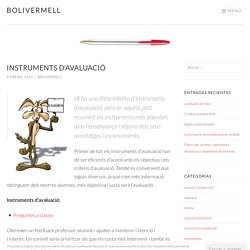
75 Digital Tools and Apps Teachers Can Use to Support Formative Assessment in the Classroom. There is no shortage of formative assessment strategies, techniques, and tools available to teachers who use formative instructional practice in their classrooms. Here is an extensive list of 75 digital tools, apps, and platforms that can help you and your students use formative assessment to elicit evidence of learning.
We didn’t just add any old tool to this list. Here are the criteria we used for those that made the cut: Supports formative instructional strategies and ways to activate learners to be resources for themselves and peersIs free or awful close to it (under $10 per year, where possible)When possible, both students and teachers can take the activator role (sometimes teachers need to get things started) The tools Animoto Gives students the ability to make a short, 30-second share video of what they learned in a lesson.Answer Pad Allows teachers to capture data from students using the web or the app. Learn more. Performance Assessment Resource Bank. Assessment resources. Reliability, Validity and Practicality. How do you know if a test is effective?
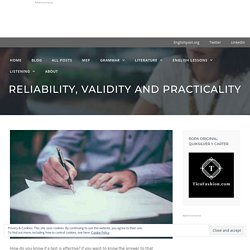
If you want to know the answer to that questions, you have to respond these questions about the test itself: Can I apply the test within appropiate administrative constraints? Does the test measure what you are trying to measure? Can the test be score by different teachers and yield similar results? If you can answer positively to those three and other related questions, your test is an effective test or in other words your test is reliable, practical and valid. Let’s explore those three concepts a little bit more: Reliability A reliable test means that it should give the same results for similar groups of students and with different people marking.
There are factors that contributes to the unreliability of a test such as: Validity To make a valid test, you must be clear about what you are testing. Practicality. Reliability and Validity. Written by Colin Phelan and Julie Wren, Graduate Assistants, UNI Office of Academic Assessment (2005-06) Reliability is the degree to which an assessment tool produces stable and consistent results.
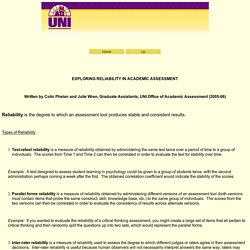
Learning Tools in the 21st Century. Assessment, to many students horror, is a necessary part of any educational process.
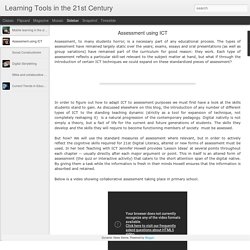
The types of assessment have remained largely static over the years; exams, essays and oral presentations (as well as group variations) have remained part of the curriculum for good reason: they work. Each type of assessment reflects a particular skill-set relevant to the subject matter at hand, but what if through the introduction of certain ICT techniques we could expand on these standardized pieces of assessment? In order to figure out how to adapt ICT to assessment purposes we must first have a look at the skills students stand to gain. As discussed elsewhere on this blog, the introduction of any number of different types of ICT to the standing teaching dynamic (strictly as a tool for expansion of technique, not completely reshaping it) is a natural progression of the contemporary pedagogy. This isn't strictly an assessment using ICT, but it reflects some of the changes required.
Assessment Matters. Assessment Practices: Assessment For, OF and AS Learning. 1 Assessment For, OF and AS Learning click here for sources and additional resources The Eight Big Ideas 1.
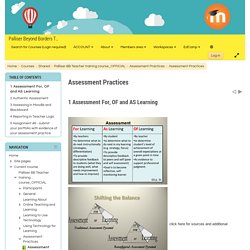
Difference Between Assessment and Evaluation (with Comparison Chart) - Key Differences. Assessment is defined as a process of appraising something or someone, i.e. the act of gauging the quality, value or importance. As against, evaluation focuses on making a judgment about values, numbers or performance of someone or something. Assessment is made to identify the level of performance of an individual, whereas evaluation is performed to determine the degree to which goals are attained. The basic difference between assessment and evaluation lies in the orientation, i.e. while the assessment is process oriented, evaluation is product oriented.
The article presented to you describes all the distinguishing points between these two.